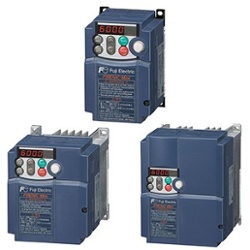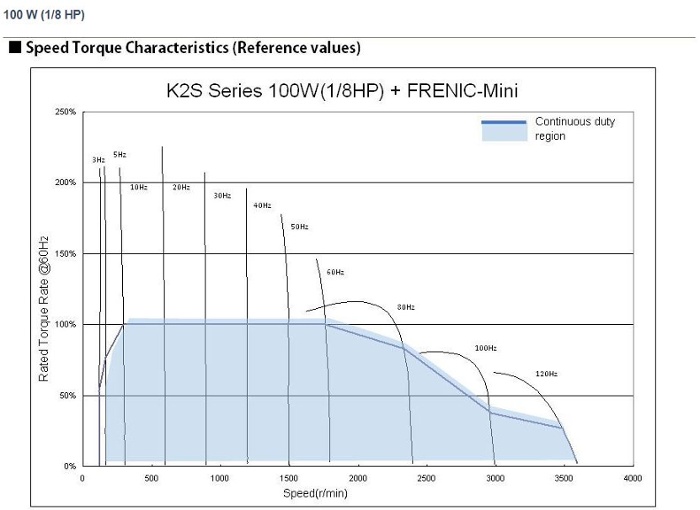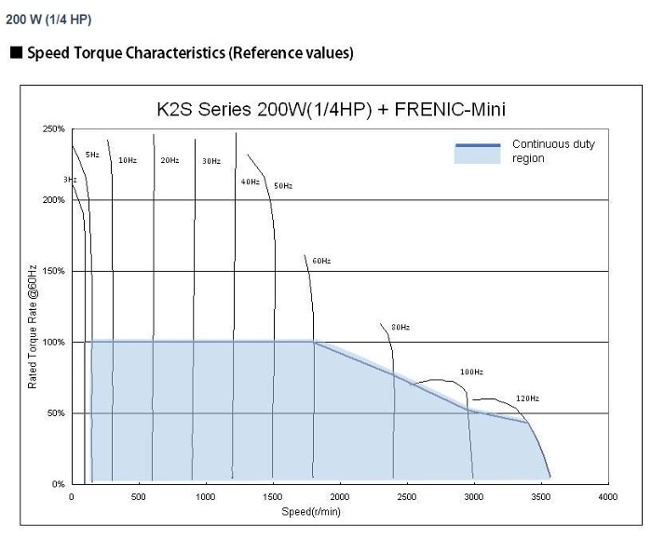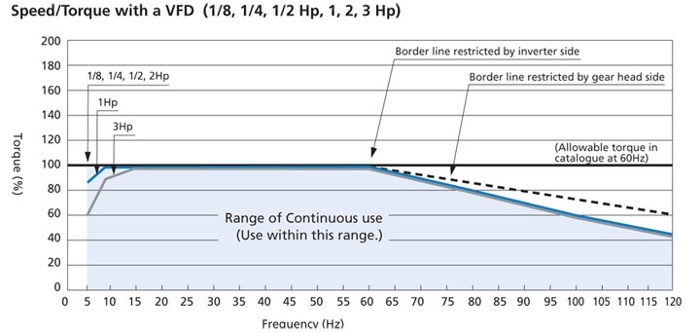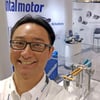The differences between single-phase and three-phase AC induction motors don't stop with the input power supply. There are a few things you need to know when using three-phase AC induction motors in an instantaneous forward/reverse operation.
What is an Instantaneous Forward/Reverse Operation?
An instantaneous forward/reverse operation describes a motor that is rotating back and forth between two positions repeatedly. An application example could be a connector test fixture that inserts and retracts the connector to test its reliability. This can be done with AC motors, brushless motors, servo motors, or stepper motors. They all can reverse direction. The deciding factor is how fast and how accurately you want the motor to stop when commanded to stop.
Credit: Mathworks
What are the Differences Between Single and Three-Phase AC Induction Motors?
1. Windings
First, the winding design is different. The primary and secondary windings are more balanced with three-phase motors than with single-phase motors. In this case, we mean the electrical specifications of the winding. Please see the table below.
| Power Supply (VAC) | Motor | Primary Winding | Secondary Winding | |
| Phase U (Ohms) | Phase V (Ohms) | Phase W (Ohms) | ||
| Single-Phase 200/220/230 | 4IK25A-CW | 157.6 | 157.1 | n/a |
| Three-Phase 200/220/230 | 4IK25A-SW | 179.9 | 179.9 | 179.9 |
2. Performance
Different winding specifications affect the motor's speed-torque characteristics. In the image below, we compare the speed-torque curves for a single-phase motor and a three-phase motor.
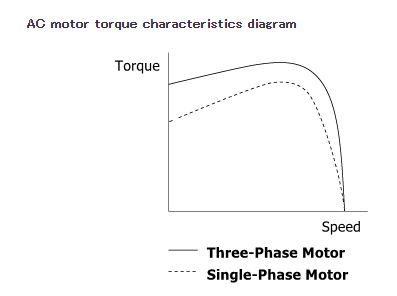
By having more available torque in the lower speed region, three-phase motors offer more starting torque and are better for instantaneous forward/reverse operation. When a single-phase motor stops and reverses, the lower torque may cause the motor to accelerate slower to its rated speed. When a three-phase motor stops and reverses, the higher torque allows it to accelerate up to its rated speed faster.
3. Starting Torque
FYI single-phase motors do not stop immediately. Unless they are used with some type of friction, electromagnetic, clutch brake mechanism, or electronic brake pack, they will coast to a stop. The coasting distance, or overrun, depends on friction and inertial load, but it can be as much as 30 revolutions (at the motor shaft; divisible by gear ratio). This overrun doesn't work well with the "instantaneous" part of an instantaneous forward/reverse operation since the motor now needs time to accelerate up to its rated speed every single time it starts. If you switch direction too quickly without waiting for the motor to decelerate to a stop, the motor may keep rotating in the same direction.
The overrun is the same between single-phase and three-phase AC induction motors once power is removed, although the higher starting torque from three-phase motors makes them ideal for instantaneous forward/reverse operations.
| TIP #1: Stop a Three-Phase Motor Before Reversing Direction |
|
If you want the motor to last, here are two reasons why you should stop the motor first before reversing its direction. The best method is to allow the motor to come to a complete stop before switching direction. Otherwise, testing is recommended.
Gear Damage In some cases, the gears in a geared motor can be damaged at the moment of reversal. If the direction of the motor is switched too quickly, the load may still keep rotating in the same direction, but the motor is actually trying to rotate in the opposite direction. Since torque works in both directions, the gears may be damaged. Minimizing impact forces for the gears inside the motor's gearhead can prolong its life. The higher starting torque from three-phase motors makes the problem worse. Risk of Power Short Circuit The internal wiring of the windings inside a single-phase motor and three-phase motor is different. Therefore, the external wiring method and the type of switch differs. In the diagram below, we show both a single-phase motor and a three-phase motor wiring diagram.
Differences in Wiring:
The first thing you probably noticed is the capacitor that's shown in the single-phase motor wiring diagram. A capacitor turns a single-phase power supply to a polyphase power supply. A polyphase power supply is necessary to create a rotating magnetic field inside the motor. The second thing you probably noticed is the number of wires we need to switch in order to reverse rotation of the three-phase motor (MC). With a single-phase motor, a SPDT (single pole double throw) switch can do the job. However, with a three-phase motor, a "lossless" electromagnetic switch that offers a interlock structure is required. This type of switch does not allow two contacts to be turned on at the same time. If any of the two wires are powered at the same time, it could create a power short circuit, then the circuit breaker could stop the motor. There is no risk with single-phase motors since there's only one pole to switch. |
Brake Frequency
Brake frequency is limited by the temperature rise of the motor, and temperature rise is mostly affected by the inrush current, which happens when you turn on a motor. Inrush current is higher than the normal rated current, and current is proportional to temperature, so the more the motor is cycled ON/OFF, the higher the temperature rise.
To determine the maximum brake frequency, testing is recommended. For both single and three-phase induction motors, it's recommended to allow 2 or 4 seconds minimum per cycle (depending on motor size) before the next cycle. That comes out to be about 30x a minute for 6~40 W motors, and 15x a minute for 60~90 W motors. It's OK to exceed these reference values as long as you can maintain the temperature, but remember, a higher temperature will decrease long-term life.
| TIP #2: Use an Inverter |
|
Another way to control the direction of three-phase motors is to use an inverter, or VFD (variable frequency drive). A VFD is designed to control the direction and speed of three-phase motors (and much more), so instantaneous forward/reverse operations can be done much easier. In addition to the popular World K series of standard AC motors, Oriental Motor's newer KIIS series of high torque three-phase AC motors were designed to work with VFDs. |
Speed-torque curves below depict the expected performance of a specific motor and VFD combination.
Feel free to click on the curve data above to learn more about these motors.
Final Thoughts
Remember, an instantaneous forward/reverse operation is not only limited to three-phase motors only. Any motor can perform forward/reverse operation, the deciding factor is how "instantaneous" and how "accurate" you want the operation to be. There are always trade-offs.
Different types of motors offer different overrun and brake frequency specifications. A single-phase reversible motor uses a friction brake to reduce its overrun drastically for instantaneous forward/reverse operations. While the overrun is reduced to 2 revolutions at the motor shaft, the heat generated from the friction brake limits the duty cycle to 30 minutes at a time. For high frequency braking applications, we recommend either an electromagnetic brake motor (50 cycles per minute) or a single-phase motor with a brake pack (60 cycles per minute).
For applications requiring instantaneous stops but not a specific stop accuracy value, a brushless motor system with a dynamic braking system may suffice. Stepper motors or servo motors actually offer the best stop accuracy, starting torque, and stop accuracy for instantaneous forward/reverse operations, but it takes more to control these motors than an AC reversible motor.
Here's some comparison data between all the motors that can perform forward/reverse operations. Remember these overrun values are at the motor. If you add a gearhead, divide the overrun by the gear ratio. These are reference values only.
Oriental Motor offers a full line of AC induction motors from 1 W (1/750 HP) to 2,237 W (3 HP). In addition to induction motors, reversible motors, electromagnetic brake motors, clutch/brake motors, and washdown motors are also available. Various types of gearheads can be added for high torque applications. Product series groups vary by type(s) of motor and features. For example, the World K Series is our standard AC motor series that includes many types of motors from induction to electromagnetic brake types. The KIIS Series is the three-phase portion of the KII Series, which retains the high torque characteristics from the KII Series plus the new three-phase speed control features.
With such a wide product breadth, a motor sizing consultation with our technical support engineers is recommended to narrow down your product options.
Here's a breakdown of our entire line of three-phase AC motors.
- World K Series (1~150 W): single-phase & three-phase; standard type
- K2S Series (30~200 W): three-phase; optimized for VFDs
- Brother Mid G3 Series (1/2~3 HP): three-phase; high power
On our website, we break these down into "constant speed" and "speed control" AC motors. While "Constant Speed" AC motors include both single-phase and three-phase types, "3-Phase AC Motors for VFDs" focuses on only three-phase motors that are designed for speed control.
Please subscribe to this blog on the top right corner of the page.

.jpg?width=600&name=Wiring%20comparison%20(translated).jpg)
